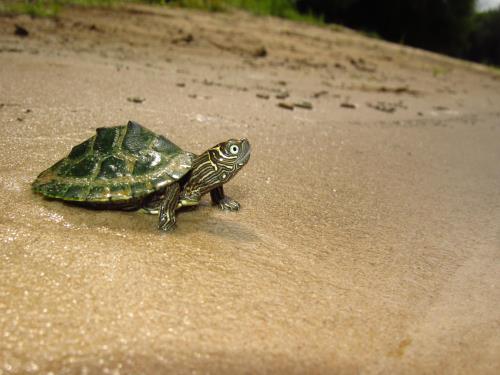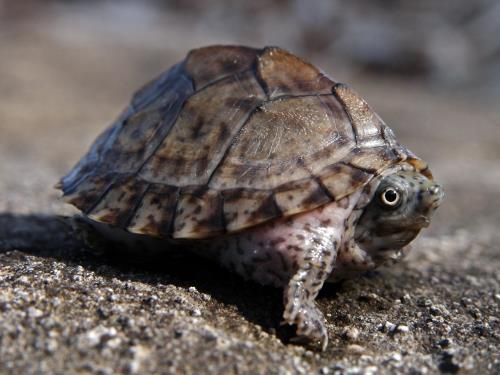Best Pet Turtle Species for Beginners
Turtles make incredible pets to love and share your home with. They are diurnal so they are active during the day when we are and that makes it much easier to enjoy seeing them out and about. They spend the majority of their time in the water swimming, but when they need to warm up they will climb out onto a piece of décor in their terrarium in order to bask under a warm light. Since they are diurnal, active during the day, UVA and UVB are incredibly important to keeping them healthy. Without access to proper UV lighting, they can develop bone deformities, become paralyzed, and in extreme circumstances can die. Make sure before getting any pet that you read as much as you can about where they come from, how they utilize their habitat, what they eat, and how to create that environment for them in captivity. Below are some species that make amazing pets but are also easier to care for than many other species.
Before we dive into that, while there are a lot of amazing reasons to keep a pet turtle, there are also some things to think about before we swim any further. First of all, since turtles live most of their life in the water, that means the water is also their dinner plate, garbage disposal, and toilet. Buildup of waste happens quickly so turtles require large filters and weekly water changes. This can make keeping a turtle a bit more work than other types of reptiles. Second, turtles can live over 100 years! Fortunately, most species available as pets typically live 25-40 years. Even though that’s much less, it’s still a serious commitment over a large portion of your life. Finding a home for your pet turtle may not be easy, so don’t get a turtle if you don’t believe you can be its one and only home for its entire life. Lastly, many species of turtle can get quite large. Species with the name “Slider” or “Cooter” are generally much larger pond turtles that can reach a length of 14 inches. These highly aquatic and active large turtles require very large homes. While we will focus on species that don’t get that large, make sure you understand how large your pet will get as an adult and that you will have the room to keep them and their aquatic habitat.
Mississippi Map Turtles (Graptemys pseudogeographica)

Mississippi Map Turtles are first on our list for a long list of reasons. The biggest one being their smaller size with large females reaching eight inches and males only getting up to five inches. This makes them much easier to keep in a standard aquarium or turtle pond in your home. This species is adapt at swimming and is frequently found around permanent bodies of moving water such as rivers and streams, but are also found in nearby ponds and lakes. They love to bask and will frequently be basking on a rock or log with their arms and legs stretched out to absorb as much sun as possible. They get the name “Map Turtle” from the lines on the scutes of their shell that look like topographical maps. They also have lines of yellow all over the skin of their head and legs which gives them a very unique and attractive look. Mississippi Map Turtles are also very personable and intelligent. Highly motivated by food, they will often swim right up to their owners looking for treats. As they grow, you’ll notice much longer nails on the front feet of males which makes it pretty easy to determine male or female.
Razorback Musk Turtles (Sternotherus carinatus)

While the word “musk” in Razorback Musk Turtle is due to the musky odor they can emit to deter predators, they only give off the smell when scared or threatened. Rarely do they emit the musky odor in captivity and they also produce much less waste than other species causing almost no smell. Like most musk turtle species, Razorback Musk Turtles are almost fully aquatic. While they will come out to bask, it’s not nearly as often. They are also much more sedentary than most other turtle types. In general, musk turtles stay small reaching only six inches. With their small size and sedentary lifestyle Razorback Musk Turtles make great pets and are an easy species of turtle to keep. In the wild, musk turtles spend most of their time in shallow water hunting for invertebrates and small fish to eat. While they don’t bask out of the water often, they will climb up on rocks to warm up so make sure to provide them an easy area to climb out and get some rays. While small, these turtles are incredible ambush predators with strong jaws. Be careful when holding them as they are prone to try and bite. Remember, to them you’re a huge scary predator!
Eastern Box Turtle (Terrapene carolina carolina)
.jpg)
For this one, we’re looking outside of the water. Many people don’t consider box turtles as an option when thinking about keeping a pet turtle. Box turtles live most of their life on land and only rarely are found in or around water. When they are found near water, it’s usually swamps or marshes with shallow water and a lot of debris to climb out onto. This is a pretty big benefit when thinking about keeping a pet turtle since there is no water to have to change or filters to clean. As you can imagine, they require a completely different enclosure design when trying to create the perfect home. Eastern Box Turtles are found throughout the eastern and central portions of the United States. They tend to be found in forests and grassland habitats. They spend their time burrowing in the dirt and leaf litter of the forest floor looking for food and walking around looking for mates and food. In the wild they eat a variety of insects such as grasshoppers, worms, caterpillars, and crickets, but they will also eat vegetation and even carrion when they find it. At home it is important to provide them with a wide variety of nutrition. A great resource for them is Zilla Reptile Munchies Omnivore Mix with Zilla Reptile Munchies Mealworms as a treat. Live foods such as Dubia roaches, crickets, and night crawlers make great additions along with fresh vegetables.
Shell-abrate Good Times, COME ON!
While there is some great information above and on the linked Zilla Husbandry Handbook Care Sheets, these are just a few places to start when it comes to learning about your new pet. Make sure to research online as well as look for a good book on the type of turtle you decide to share your home with. Turtles are found on every continent except Antarctica and their habitats can vary widely so finding the details of your specific turtle species is important. With proper habitat, heating, lighting, and diet, you will have decades to spend with your turtle friend.
